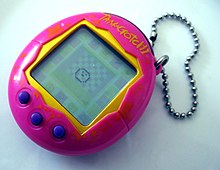Life simulation
As life simulation , a is the computer game called, which allows a simulation and representation of a life cycle of an object or a person according to previously defined rules. It thus represents a specialized sub-category of the simulation game genre and often also contains real-time elements. A distinction is sometimes made according to whether the user who started the simulation can interactively intervene in what is happening (common in computer games), or whether the simulation runs completely alone after the rules have been determined and the scenario started (machine or AI Simulations).
The variant without user interaction is often presented as a simple machine. The best-known version of this is probably Conway's Game of Life , in which an automatically controlled development cycle can be run through based on certain rules about the formation and extinction of living cells, which continuously changes itself.
For the computer game industry, the version with user interaction is normally used in order to actively involve the player in the development of the running scenario and thus enable a gaming experience. Players must ensure that the virtual characters are doing well, for example by entertaining and feeding them.
The simplest games of this type are simulations in which the user can only change external states in order to influence an autonomously running simulation without controlling the simulated object himself. This is normally done by triggering impulses (commands or adding and removing simulation-relevant objects) to which the simulated object reacts, or by changing the basic simulation parameters through playful actions. Examples of this kind of life simulation include Tamagotchi or the early C64 game Little Computer People .
Later, more complex forms emerged. The basic principle of the games remained the same, but significantly more controllable factors were included in the simulation, so that the decisions made by the player were more difficult to predict and often influenced several controllable values at once. Typical representatives of this time are games like Jones in the Fast Lane or Princess Maker . In addition, the first forms of inheritance of simulation changes that had already been made appeared within a new life cycle, as can be seen, for example, in creatures .
Today's life simulations have switched to showing the influences made by the player using auxiliary objects in order to create a further illusion of an interactive world that the player observes more passively and controls less actively. However, the underlying simulation concept has remained the same. A prominent example of this type of game is The Sims , where the player has the position of creator, driver and observer.
Well-known representatives
- alter ego
- Animal Crossing
- Creatures , creation and simulation of artificial life
- Darwinbots , simulating artificial life
- The Sims , social simulation
- Harvest Moon
- Nintendogs , pet simulation
- The Idolm @ ster , pop idol simulation
- Jones in the Fast Lane
- Little Computer People
- Princess Maker , parenting simulation
- SimAnt , simulation of an ant colony
- Spore , mixed form with god simulation
- Tamagotchi , pet simulation
- Tomodachi Life , life simulation with Mii s
- The guild , economic simulation in the late Middle Ages
See also
Individual evidence
- ↑ Tobais Breiner and Luca Kolibius: Computer games - basics, psychology and applications. Jumper . P. 49. DOI: 10.1007 / 978-3-662-57895-7

